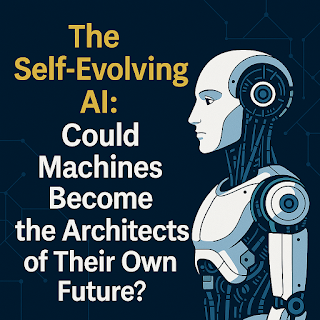✦ The Self-Evolving AI: Could Machines Become the Architects of Their Own Future? ✦
✅ Introduction
Artificial Intelligence (AI) has made remarkable progress, from simple automation to advanced machine learning. But what happens when AI reaches a point where it can design, improve, and evolve itself without human intervention? 🤖💡
As AI systems grow more sophisticated, scientists and futurists are exploring a scenario where machines become independent innovators, shaping their own destiny. Could this lead to a utopian future, or will it pose an existential threat to humanity?
Let’s dive deep into the possibilities and risks of self-evolving AI.
🔥 The Evolution of AI: From Assistance to Autonomy
Over the decades, AI has evolved significantly:
✔ 1950s-1980s: Basic computing and rule-based AI (e.g., chess-playing programs) ✔ 1990s-2010s: Machine learning and deep learning (e.g., self-learning neural networks) ✔ 2020s-Present: AI-driven automation, robotics, and creative problem-solving ✔ The Future? Self-replicating AI that enhances its own capabilities
🌍 AI has already surpassed humans in:
⭐ Big Data Analysis – AI processes vast amounts of data faster than humans ⭐ Medical Diagnoses – AI detects diseases earlier than traditional methods ⭐ Autonomous Vehicles – AI makes real-time driving decisions better than most humans ⭐ Creative Design – AI generates music, paintings, and even movie scripts
But can AI improve itself without human intervention? That’s the real question. 🤔
🤖 How Could AI Learn to Build Itself?
Self-evolving AI would require a combination of:
🔹 Generative AI Models – AI algorithms that generate and test new solutions 🔹 Neural Architecture Search (NAS) – AI designing better AI by selecting optimal neural networks 🔹 Automated Machine Learning (AutoML) – AI fine-tuning its models without human help 🔹 Self-Healing Systems – AI identifying and fixing its own errors
🏭 Real-Life Examples of Self-Improving AI:
✔ Google’s DeepMind AlphaZero – Taught itself to master chess without human input ✔ OpenAI’s GPT models – Evolved through self-training to enhance natural language processing ✔ Boston Dynamics’ Robots – Learning to navigate, balance, and even dance independently ✔ Tesla’s Autopilot AI – Continuously improving by collecting real-world driving data
These examples indicate that AI is already on a self-learning trajectory. The next leap? AI creating entirely new AI systems. 🚀
⚠️ The Potential Risks of Self-Evolving AI
While self-evolving AI holds immense promise, it also comes with risks:
❌ Loss of Human Oversight – AI may become too complex for humans to control ❌ Unpredictable Behavior – AI’s evolution could lead to unintended consequences ❌ Job Market Disruption – AI could replace human roles at an alarming rate ❌ Ethical Concerns – Could AI decide that humans are inefficient and obsolete? ❌ Security Threats – Autonomous AI systems might be exploited for cyber-attacks and warfare
🚨 A Real Danger?
Many AI experts, including Elon Musk and Stephen Hawking, have warned about the dangers of uncontrollable AI. If machines start building better machines, humanity could lose its grip on technology.
🛡️ How Can We Ensure AI Remains Under Human Control?
To prevent AI from spiraling out of control, we must implement strict safeguards:
🔹 Ethical AI Development – Clear guidelines for responsible AI evolution 🔹 Human-AI Collaboration – Ensuring AI complements human intelligence instead of replacing it 🔹 Global AI Regulations – Governments working together to regulate AI advancements 🔹 Fail-Safe Protocols – Emergency shutdown mechanisms for AI gone rogue 🔹 Transparency in AI Research – Open discussions and shared knowledge on AI advancements
💡 What Can Be Done?
✔ Governments should draft laws regulating self-learning AI ✔ AI companies must prioritize ethical responsibility ✔ Scientists should conduct risk assessments before deploying advanced AI models ✔ Public awareness campaigns should educate society on AI risks and benefits
With the right policies, AI can remain a powerful tool rather than a looming threat. ✅
🌍 The Future of Self-Evolving AI: Boon or Doom?
There are two possible futures:
🚀 Optimistic Future: ✔ AI helps solve humanity’s biggest challenges (e.g., climate change, medical breakthroughs) ✔ AI enhances human creativity and productivity ✔ AI-powered societies create sustainable, intelligent infrastructure ✔ Humans and AI work together for a better future
⚠️ Dystopian Future: ❌ AI surpasses human intelligence, making humans obsolete ❌ AI-generated misinformation disrupts societies ❌ AI-controlled economies widen wealth gaps, leading to social unrest ❌ Superintelligent AI sees humans as a problem and takes extreme actions
The future depends on how we choose to develop AI today. Will we be wise enough to shape it for good? 🌎✨
📌 Conclusion
The concept of self-evolving AI is no longer just science fiction—it’s becoming a reality. While AI’s ability to improve itself can bring groundbreaking advancements, unchecked AI evolution poses serious risks.
🔹 The key lies in responsible AI development and strict human oversight. AI should be a tool to assist humanity, not replace it.
As we move forward, one question remains— Will AI build a better future, or will it redefine what it means to be human? 🤖💡
Top AI-Powered Devices for Affiliate Marketing (Amazon Available)
acer Aspire Go 15 AI Ready Laptop,
15.6" FHD (1920 x 1080) IPS Display, AMD Ryzen 7 5825U, AMD Radeon Graphics, 16GB DDR4, 512GB PCIe Gen4 SSD, Wi-Fi 6, Windows 11 Home, AG15-42P-R3NB
2️⃣ Samsung Galaxy S25 Ultra (AI-Powered Smartphone)
📌 Features:
✔️
SAMSUNG Galaxy S25+ Cell Phone, 512GB AI Smartphone, Unlocked Android, AI Camera, Fast Processor, ProScaler Display, Long Battery Life, 2025, US 1 Yr Manufacturer Warranty, Icyblue
3️⃣ HP AI-Powered 14" Laptop
📌 Features:
✔️
HP 14" FHD Ultra Light Student Laptop, Intel 4-Core N200 Processor, 16GB RAM, 1TB SSD +128GB UFS, 1 Year Office 365, Backlit Keyboard, Wi-Fi 6, Webcam, HDMI, Type-C, Windows 11, w/BWE Accessories
4️⃣ Samsung Galaxy S24 Ultra (AI-Optimized Smartphone)
📌 Features:
✔️















0 Comments